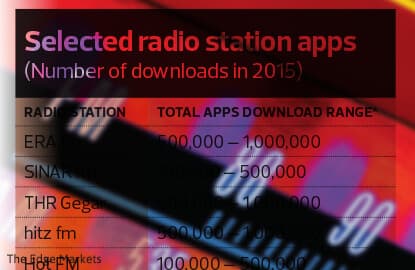
WITH the growing number of free online radio stations on the internet, is a radio licence still a necessity? Today, a licence can set one back as much as RM20 million.
Industry players believe there is still value in a radio licence, partly due to the scarcity and because the frequency offers an instant captive audience.
“There are thousands of online radio stations. But the content needs to resonate with listeners. Would you listen to Rush Limbaugh and his diatribes on American liberals? Your reaction is probably, who is Rush Limbaugh? Local radio stations will survive if the content they offer resonates with local listeners,” says BFM CEO Malek Ali.
“The second challenge for free online radio is that you are just like any other website and it is immensely difficult to stand out amid the noise. It is an awareness and differentiation problem. An FM radio frequency, at least for now, gives you the opportunity to reach a captive audience in the car. So, the challenge shifts from differentiating yourself from among thousands of online radio stations to being different from the other 20-plus stations on the car radio.
"Having said that, dashboard technology is going through radical innovations right now, so the days of thousands of radio stations in our cars will be upon us sooner than we think. So, continuing to make our content the one that resonates the most, that it is one of 10 presets on your new-fangled car dashboard, will be the key factor for radio stations to continue to thrive,” Malek says.
Traditional radio continues to be effective in reaching listeners here in Malaysia. Statistics show that 9 out of 10 persons aged 10 and above in Peninsular Malaysia tune in to their favourite radio stations.
The scarcity of radio licences in the market has led Astro Malaysia Holdings Bhd to enter into acquisition talks for Star Media Group Bhd’s radio stations — Capital FM and RED FM — says the former’s chief operating officer Henry Tan. “The scarcity makes the acquisition more compelling. We have existing infrastructure in place and we think we can apply that to new acquisitions without having to over-invest in them.
“FM has a lot of value. If you look at so-called ‘online options’, it is a fragmented market place. There is a difference between radio and music. Some position themselves as music, we still see ourselves as radio — a companion and friend.”
Public Investment Bank research says it expects Astro to be able to leverage its existing resources and talent to capture audience interest in the new stations.
“As radio broadcasting spectrums and frequencies are limited in Malaysia, media companies have no option but to acquire existing licences in order to expand their portfolios. The newly acquired radio stations, which will broadcast via on-air and online platforms, will be revamped and rebranded to capture a new target market,” it says in a Sept 13 report.
Hong Leong investment research points out that since 2012, Astro’s radio segment has seen steady growth (compound annual growth rate of 11%) with a healthy earnings before interest, taxes, depreciation and amortisation margin of 48% to 58%.
“The inclusion of two new FM radio stations will increase Astro’s presence in the privately owned radio station [space] from 34.6% to 42.3%. In the financial year 2015 (FY2015), Astro managed to secure about 59% of total radio advertising expenditure [and] this acquisition will allow Astro to cement its position with a bigger bite of the total radio adex,” it says in a Sept 13 report.
Astro’s Tan does not see any increase in its radio adex as monopolistic. “It is a level playing field. Everyone knew the two stations were up for sale … anybody could bid for them.”
Meanwhile, a fairly new entrant to the radio business scene — Cense Media group — took the spectrum route rather than starting up online as it believes it gives it the reach it needs locally.
“Spectrum gives you reach that the internet can as well … but with spectrum, you can reach remote and rural areas. Broadcast is the best way to reach these areas. That is why we started Kupi-Kupi FM in Sabah, which is in Malay and the local Kadazan Dusun Murut languages. We are also testing out our frequency in Sarawak, which will be in the Chinese language,” says Rita Sim, director and co-founder of Cense Media Group.
“Statistics also show that radio is still the best way to communicate with people who are driving and stuck in traffic jams. We have over 20 million vehicles on the road in the country, with at least half of them cars. And nowadays, people do not live so close to the city, so they have to spend a longer time commuting.”
“The competition out there is not with the other radio stations, instead radio stations now have to compete with disruptions like Pokémon Go and apps. Basically, competition is anything that takes away attention from us,” says Datuk Jake Abdullah, president of Commercial Radio Malaysia.
“When you figure out consumption, you win. Today, we need to work harder to appeal to listeners who wake up to their Facebook and Instagram accounts.”
Save by subscribing to us for your print and/or digital copy.
P/S: The Edge is also available on Apple's AppStore and Androids' Google Play.